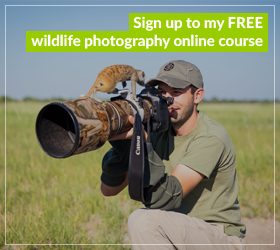The BBC recently set me a challenge: to recreate my African Wildlife at Night photos here in the UK. This was daunting because British wildlife does not lend itself to the same approach that I used to photograph animals such as lions and hyenas in Africa. I was going to need to come up with something different!
You can watch the resulting film I made with Mike Dilger from The One Show below and then read on to learn more about the project…
First task was to identify a subject. I wanted to capture the night sky behind the subject, so it needed to be an animal that I could look up at. After much deliberation, we settled on one of my favourite birds: the beautiful barn owl.
The One Show producers then found the perfect location: Stow Maries Aerodrome in Essex. This is an old World War I aerodrome, which has mostly been turned over to nature. Wildlife now thrives and it is home to several pairs of barn owl. Best of all, it is only a 90 minute drive from my house!
Next, I needed to figure out a technique. I didn’t want to blind the owls so I decided to shoot in infrared. This meant placing a filter over my flashes to block out all of the visible light and only letting through invisible infrared light. I also modified my camera to make it more sensitive to infrared light. Now I would be able to photograph the owls without upsetting their sensitive night vision. Since I was shooting in infrared, the final images would be converted to black and white.

I decided this would be a perfect application for a camera trap. I would use my Camtraptions Motion Sensor to detect when an owl landed on a stump and automatically trigger my DSLR camera. I could then leave the camera in place for as long as it would take to get the shot. Little did I know that the camera would be running continuously for almost four months!
The first image I wanted was one showing the stars in the night sky. To achieve this, I would use a long exposure time of over 30 seconds. The flash would fire at the start of the exposure to illuminate the owl. There’s plenty that can go wrong with a shot like this, especially if the owl moves and ambient light exposes the scene behind. The English weather and short summer nights also made it very unlikely that I would get the owl landing when conditions were perfect. However, it was worth a shot…
After several months of perseverance, I achieved a selection of images showing this beautiful bird in it’s nocturnal world.
On full moon nights, it was likely that there would be too much ambient light for long exposures, so I also took some shots in which I just exposed the owl. This resulted in one of my favourite images from the project of an owl landing on the stump with it’s wings perfectly positioned in the frame…
A big thank you to all involved from the The One Show and the team at Stow Maries. You can view more of the photographs from this project here. If you would like to learn more about the camera trap techniques I used to take these photographs, please download my free guide to remote and camera trap photography.






Awesome trick and awesome captures sir 👌😊
excellent, very good photos and an advanced technique.
I will order my PIR sensor for Christmas, because I have many wishes to try this mode of photography in bats feeding on fruits.
this is really MAGNIFICENT like your work very much and this is phenomenal
Nature is healing ,and these artistic photographs reflect that energy
That is flawless sir…. Really want to learn wildlife photography……. As I am a beginner
Hey, nice project, I want to do something similar, I have some areas used by barn owl, and i’m developping electronic PIR sensor myself! I hope to have luck like you. I already tried some years ago, but I can’t put my camera trap many days… How did you do to save battery consumption ? especially between camera and flash (which wireless shutter do you use to fire the flash?)
Can you capture beautiful India in your camera ? 🤓